Cine s-a întâlnit cu Catherine II?
Alexander Yermolov datează Catherine II de la ? până la ?.
Ivan Rimsky-Korsakov datează Catherine II de la ? până la ?. Diferența de vârstă a fost de 24 ani, 8 luni și 22 zile.
Alexander Dmitriev-Mamonov datează Catherine II de la ? până la ?. Diferența de vârstă a fost de 29 ani, 4 luni și 28 zile.
Alexander Lanskoy datează Catherine II de la ? până la ?. Diferența de vârstă a fost de 28 ani, 10 luni și 6 zile.
Sergei Saltykov datează Catherine II de la ? până la ?.
Pyotr Zavadovsky datează Catherine II de la ? până la ?. Diferența de vârstă a fost de 9 ani, 8 luni și 19 zile.
Semyon Zorich datează Catherine II de la ? până la ?.
Alexander Vasilchikov datează Catherine II de la ? până la ?.
Platon Zubov datează Catherine II de la ? până la ?. Diferența de vârstă a fost de 38 ani, 6 luni și 24 zile.
Gregory Potyomkin datează Catherine II de la ? până la ?. Diferența de vârstă a fost de 10 ani, 4 luni și 22 zile.
Grigori Grigorievici Orlov datează Catherine II de la ? până la ?. Diferența de vârstă a fost de 5 ani, 5 luni și 15 zile.
Stanisław August Poniatowski datează Catherine II de la ? până la ?. Diferența de vârstă a fost de 2 ani, 8 luni și 15 zile.
Catherine II
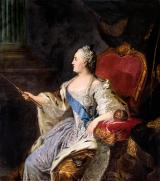
Catherine II (en russe : Екатерина II) ou Catherine la Grande (Екатери́на Вели́кая), née Sophie Frédérique Augusta d'Anhalt-Zerbst le 2 mai 1729 à Stettin en Poméranie (aujourd'hui Szczecin en Pologne) et morte le 17 novembre 1796 à Saint-Pétersbourg, est l'épouse du prince puis empereur Pierre III (1728-1762). Elle devient impératrice régnante de Russie en 1762 jusqu'à sa mort, à la suite d'un coup d'État le 9 juillet 1762, suivi de l'incarcération de Pierre III, puis de son exécution le 17 juillet par un proche de Catherine.
Prénommée Catherine lors de son baptême orthodoxe, nécessaire avant son mariage avec le prince Pierre, elle devient impératrice consort après l'avènement de celui-ci (5 janvier 1762). Après son coup d'État, elle se fait proclamer « impératrice et autocrate de toutes les Russies ».
Elle règne personnellement sur l'Empire russe du 9 juillet 1762 à sa mort le 17 novembre 1796. Sous son règne, la Russie connaît une grande expansion territoriale vers l'ouest et le sud (plus de 500 000 km2), notamment à l'occasion des trois partages de la Pologne (1772, 1793 et 1795) et de guerres victorieuses contre l'Empire ottoman.
Citește mai mult...Alexander Yermolov
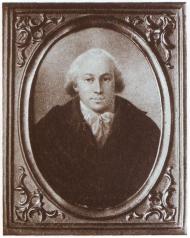
Alexander Petrovich Yermolov (1754–1834) was a Russian favourite and the lover of Catherine the Great from 1785 to 1786.
Yermolov was presented to Catherine by Grigory Potemkin, tested by Anna Protasova and became Catherine's lover in 1785. He collaborated with the enemies of Potemkin and attempted to have Potemkin removed, and thereby lost his position. He went to Paris in the late 1780s and spent the rest of his life in Schloss Frohsdorf.
Citește mai mult...Catherine II

Ivan Rimsky-Korsakov

Ivan Nikolajevich Rimsky-Korsakov, né Korsav (29 June 1754 – 31 July 1831 in Saint Petersburg, Russian Empire) was a Russian courtier and lover of Catherine the Great from 1778 to 1779.
Citește mai mult...Catherine II

Alexander Dmitriev-Mamonov

Il conte Aleksandr Matveevič Dmitriev-Mamonov (in russo Александр Матвеевич Дмитриев-Мамонов?; Smolensk, 30 settembre 1758 – San Pietroburgo, 11 ottobre 1803) è stato un diplomatico russo, appartenente ad un'antichissima dinastia della nobiltà dei boiardi discendente dei Rurichidi e con grandi possedimenti nei pressi di Smolensk.
In quanto aiutante di campo del conte Potemkin, Mamonov nel 1784 fu presentato alla zarina Caterina II, della quale in breve divenne il favorito.
Grazie al favore dell'imperatrice, che gli tributava 100.000 fiorini annui, riuscì ad istituire una piccola corte di illuministi, che tra gli altri comprendeva il conte Semën Romanovič Voroncov, Nikolaj Aleksandrovič Zubov, fratello di Platon Aleksandrovič Zubov, Pëtr Alekseevič Palen, José de Ribas, Aleksandr Andreevič Bezborodko e Nikita Petrovič Panin e inoltre Mamonov tenne un frequente scambio epistolare con il mecenate di Wolfgang Amadeus Mozart, Friedrich Melchior von Grimm.
Nel 1787 prese parte ai negoziati con Stanislao II Augusto Poniatowski e Giuseppe II d'Austria, divenendo Reichsgraf ("conte del Sacro romano impero"). Alla sua morte fu inumato nel Monastero di Donskoj.
Citește mai mult...Catherine II

Alexander Lanskoy
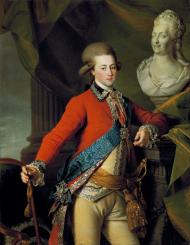
Alexander Dmitrievich Lanskoy, also called Sashin'ka or Sasha, (19 March [O.S. 8 March] 1758 – 6 July [O.S. 25 June] 1784) was a Russian general, favourite and lover of Catherine the Great between 1780 and 1784. It has been said that "[a] look at [her] correspondence with her favorites gives the impression she only had tender feelings for one, Alexander Lanskoi."
Citește mai mult...Catherine II

Sergei Saltykov

Count Sergei Vasilievich Saltykov (Russian: Сергей Васильевич Салтыков, IPA: [sʲɪrˈɡʲej vɐˈsʲilʲjɪvʲɪtɕ səltɨˈkof]; c. 1722 – 1784) was a Russian officer (chamberlain) who became the first lover of Empress Catherine the Great after her arrival in Russia.
Citește mai mult...Catherine II

Pyotr Zavadovsky
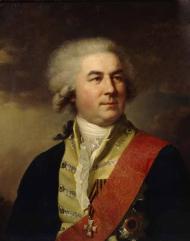
Pyotr Zavadovsky (1739–1812) was a Russian statesman of Ukrainian origin. He was a favourite (lover) of Russian empress Catherine the Great from 1776 to 1777.
Citește mai mult...Catherine II

Semyon Zorich

Count Semyon Zorich (1743–1799) was a Serbian-born Russian lieutenant-general and count of the Holy Roman Empire. He served Russia against the Prussians and Turks. A member of the Russian court, he was presented to Empress Catherine the Great by Grigory Potemkin and, after having been tested by Praskovja Bruce and doctor Rogerson, became the Empress' lover. He was most influential in the commercial development of Shklov and Mogilev.
Citește mai mult...Catherine II

Alexander Vasilchikov
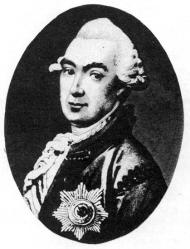
Alexander Semyonovich Vasilchikov (Russian: Александр Семёнович Васильчиков, tr. Aleksandr Semënovič Vasil'čikov; 1746–1813) was a Russian aristocrat who became the lover of Catherine the Great from 1772 to 1774.
Vasilchikov was an ensign in the Chevalier Guard Regiment when he was noted by Catherine and was appointed gentleman of the bedchamber on 1 August 1772. When Catherine's then-lover Grigory Grigoryevich Orlov left court, Catherine was informed about his adultery, and 12 August, Vasilchikov was made general aide-de-camp and lover of Catherine. Vasilchikov was expected to be available to attend on her at all times, and was not allowed to leave the palace without permission.
The relationship was short-lived. Catherine found Vasilchikov's gentleness cloying, saying "His tenderness made me weep." When Vasilchikov was away on a journey, sent by the empress, Grigory Potemkin replaced him as her lover. She wrote to her friend Friedrich Melchior, Baron von Grimm about Vasilchikov's dismissal: "Why do you reproach me because I dismiss a well-meaning but extremely boring bourgeois in favour of one of the greatest, the most comical and amusing, characters of this iron century?"
Vasilchikov later complained that he felt like a hired gigolo: "I was nothing more to her than a kind of male cocotte and I was treated as such. If I made a request for myself or anyone else, she did not reply, but the next day I found a bank-note for several thousand rubles in my pocket. She never condescended to discuss with me any matters that lay close to my heart."
Catherine characteristically rewarded her former lover richly. Vasilchikov was given a pension of twenty thousand rubles and valuable properties. He lived the rest of his life in Moscow. He never married. He built a notable collection of Western European paintings and sculptures, including a "Self Portrait" by Velasquez and works by Philips Wouwerman and Andries Botha.
Citește mai mult...Catherine II

Platon Zubov
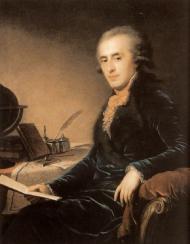
Prince Platon Alexandrovich Zubov (Russian: Платон Александрович Зубов; November 26 [O.S. November 15] 1767 – April 19 [O.S. April 7] 1822) was the last of Catherine the Great's favourites and the most powerful man in the Russian Empire during the last years of her reign.
Citește mai mult...Catherine II

Gregory Potyomkin
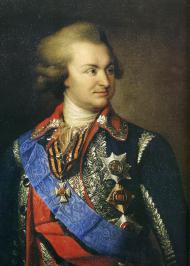
Grigori Aleksandrovici Potemkin (în rusă Григорий Александрович Потёмкин, transliterat: Grigori Aleksandrovici Potiomkin; n. , Chizhevo(d), gubernia Smolensk, Imperiul Rus – d. , Rădenii Vechi, raionul Ungheni, Republica Moldova) a fost un general-feldmareșal rus, demnitar al statului și favorit al țarinei Ecaterina a II-a a Rusiei. A murit la Rădenii Vechi, Moldova, în timpul unei călătorii de la Iași spre Nikolaev. A fost înhumat în Catedrala din Herson, Imperiul Rus (azi în Ucraina).
Termenul „potemkiniadă” este legat de numele său.
Citește mai mult...Catherine II

Grigori Grigorievici Orlov
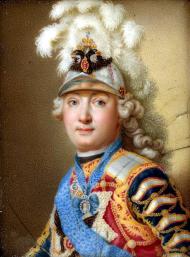
Grigori Grigorievici Orlov (în rusă Григорий Григорьевич Орлов; n. 17 octombrie 1734 – d. 24 aprilie 1783, Moscova) a fost un ofițer rus și amantul țarinei Ecaterina cea Mare.
Citește mai mult...Catherine II

Stanisław August Poniatowski
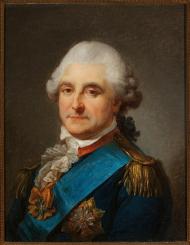
Stanisław II August sau Stanisław Antoni Poniatowski (n. , Wołczyn(d), Marele Ducat al Lituaniei, Polonia-Lituania – d. , Sankt Petersburg, Imperiul Rus), numit și Stanisław al II-lea, a fost ultimul Rege al Poloniei și Mare Duce al Lituaniei (1764-1795). A fost fiul contelui Stanisław Poniatowski (1676-1762), castelanul Cracoviei, și al principesei Konstancja Czartoryska. A fost fratele lui Michal Jerzy Poniatowski și unchiul prințului Józef Poniatowski. Tatăl lui era amantul Ecaterinei a II-a a Rusiei, ceea ce i-a facilitat urcarea pe tronul polonez. A fost ales rege la data de 7 septembrie 1764 și încoronat la 25 noiembrie în același an. Cu prilejul primei divizări din 1772, porțiuni din teritoriul polonez au fost atribuite Rusiei, Austriei și Prusiei. Perioada cuprinsă între 1773 și 1792 a fost una de renaștere națională, sprijinită de Stanisław, dar în 1793 acesta a fost forțat să accepte o a doua divizare, în urma căreia a devenit vasal de facto al Rusiei, cu un regat ciopârțit. Anihilarea Poloniei a fost definitivată în 1795, după zdrobirea unei răscoale naționaliste. În noiembrie 1795 Stanisław a fost forțat să abdice.
Citește mai mult...